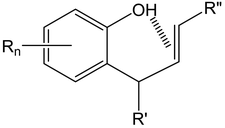Proton, electron and energy transfer processes in excited phenol–olefin dyads
Abstract
Dyads containing phenol and olefin subunits are versatile models for the investigation of proton, electron and energy transfer processes. As they are readily accessible, a number of analogues (allylphenols, cinnamylphenols and derivatives) have been prepared with a wide range of photophysical and photochemical properties. By means of appropriate structural modification of a very simple initial structure, it is possible to reproduce, at will, different types of behaviour. In addition to providing valuable fluorescence emission data, these systems are chemically productive, giving rise to irreversible photoreactions that constitute a fingerprint for the mechanism involved. They include photocyclisation to 5- and 6-membered ring cyclic ethers, Z/E isomerisation, di-π-methane rearrangement, formation of ortho-quinone methides, photohydration and photodehalogenation. This rich photochemistry is highly sensitive to the microenvironment experienced, as indicated by the dramatic modifications observed within cyclodextrin cavities. Intramolecular OH⋯π interactions, both in their ground and excited states, play a key role in the interesting properties of 2-allylphenol derivatives. This is supported by experimental data and also by theoretical calculations.


 Please wait while we load your content...
Please wait while we load your content...